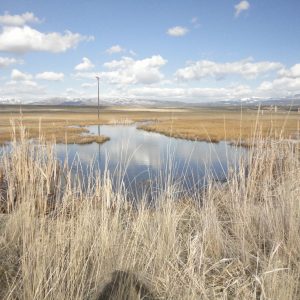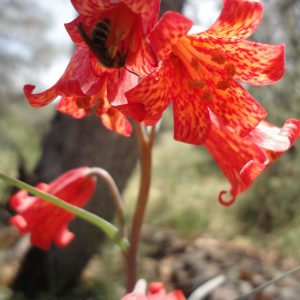My name is Mimi Jenkins and I am lucky enough to be working as a CLM intern at the Coos Bay District office of the Bureau of Land Mangement for the next six months. The first two weeks here have been an amazing introduction to the beautiful landscape I will be working on during my internship doing noxious weed inventory for Scott Knowles, a Natural Resources Specialist. I am still in awe of the rocky coasts where the Pacific Ocean crashes against the sheer cliffs or gently wades in cool, clear coves. The land is green, dominated by conifers, and covered in moss and water-loving creatures. The old growth forests laden with massive Douglas firs hundreds of years old and ferns make you realize how tiny of a speck of dust you are on this Earth.

Elk @BLM's Dean Creek Elk Viewing Site
These first couple of weeks have been mostly training and preparing for the 6 months ahead. Since many of the flora and fauna here on the Oregon South Coast are foreign to an Eastener like me, I have been attempting to quickly learn as much as I can, especially in terms of noxious weeds since I will need to accurately identify them in the field for my internship. I have gone out in the field with my mentor, Scott Knowles, and the other CLM intern here, Nathan Reese, to learn some of the noxious weeds and what the work we will be doing entails. Nathan and I will be spending our time driving out to the BLM sites as well as private lands, mostly on logging roads, and taking inventory on noxious weeds using a Trimble Juno GPS device. The data we will collect will be used when the BLM contracts out for treatment of the weeds (i.e. herbicide spraying). It’s crucial to try to control noxious weeds because they crowd out native plant species which provide important habitat for wildlife and are generally deemed to be “injurious to public health, agriculture, recreation, wildlife, or any private or public property”. For example, the western snowy plover shorebird is threatened because of loss of habitat, largely due to the introduction of European beachgrass. This exotic plant was used to stabilize the sand dunes on the coast and has since changed the topography of the dunes where the plover nests, decreasing the amount of open sand space for nesting and providing hiding spots for predators.

Snowy Plover, photo taken from BLM shared directory
In addition to training and learning from my mentor, I have had the opportunity to venture out with some of the other BLM employees, including wildlife biologists and a fish biologist. Steve Langenstein, one of the wildlife biologists, took us out to Spruce Island, a piece of land that BLM bought many years ago from a man who had brought over several foreign Rhododendron species which flourish in this area. We helped him take down some bat boxes that were no longer in use and poorly designed and put up purple martin boxes in their place. While taking down one of the bat boxes, we found 4 little brown bats sleeping, so Steve relocated them to a warm woodpile. He also showed us the BLM’s Dean Creek Elk viewing site where we ran into a herd of elk (not literally). I have also visited the BLM’s Doernir Fir, the largest Douglas Fir known to exist, with a diameter of 11.5 ft. On another day last week, we went out with some wildlife biologists doing spotted owl surveys. Species like the spotted owl and marbled murrelet which depend on old-growth forest habitat have been hard-hit due to intense logging. We hiked into a site where a pair of owls was known to live in previous years. Since we were out during the day, we didn’t anticipate seeing them but when we called them, we heard them respond and followed the sound to close in on them. Then we “moused” the pair of owls to find out if they were nesting. It was an amazing experience having a spotted owl fly 2 feet from my face to catch this mouse out on the branch I was holding. These initial experiences have allowed me to familiarize myself with the area I will be working in and learn about its biology, ecology, natural history and fantastic recreation opportunities.

Yellow Flag Iris, one of our noxious weed species, picture taken from BLM shared directory
I am excited to learn and experience as much as possible during this internship and my time on the Oregon coast. Less than five miles down the road from where I am staying is Shore Acres State Park, a gorgeous site with beautiful trails through the woods and the ocean off to your left. It contains Simpson Reef, the largest haul out site for seals and sea lions on the Pacific Northwest coast. Out on the beachy haul out site, you can see Elephant seals as well as California and Stellar sea lions. Some unique and amazing birds are common sights around here too, like bald eagles, cormorants, egrets, herons and hundreds of shorebirds, and puffins just south of here in a town called Bandon, OR. I am so excited to be able to take advantage of this amazing location, in addition to the great experience and knowledge I will gain from this internship and all my incredible colleagues here at the Coos Bay district BLM.



































